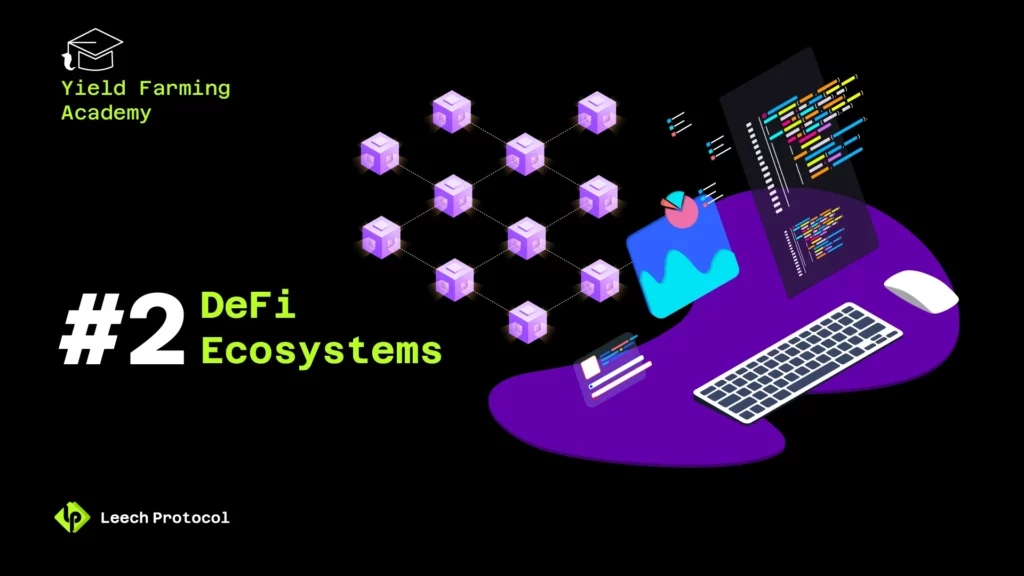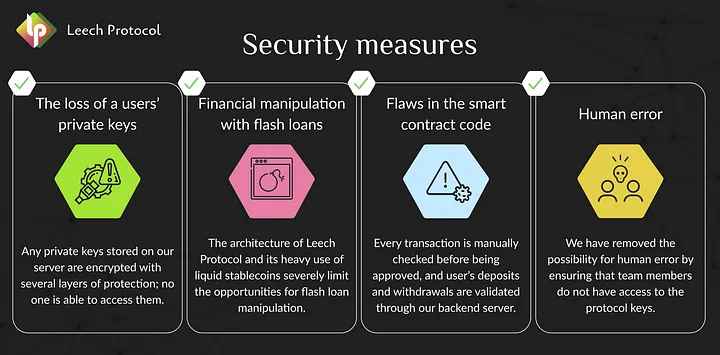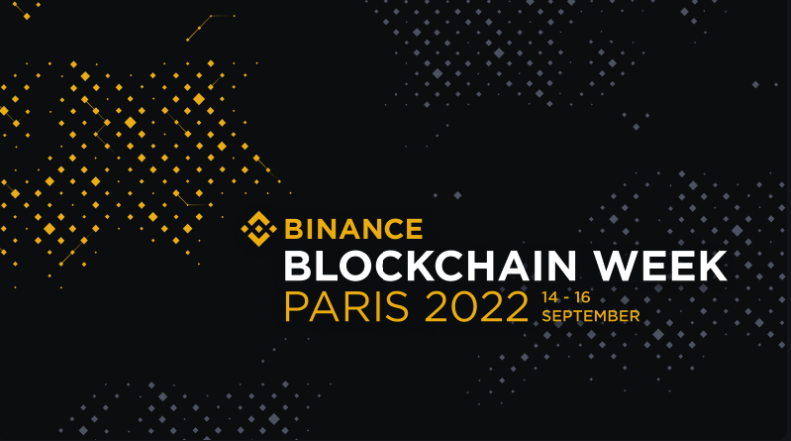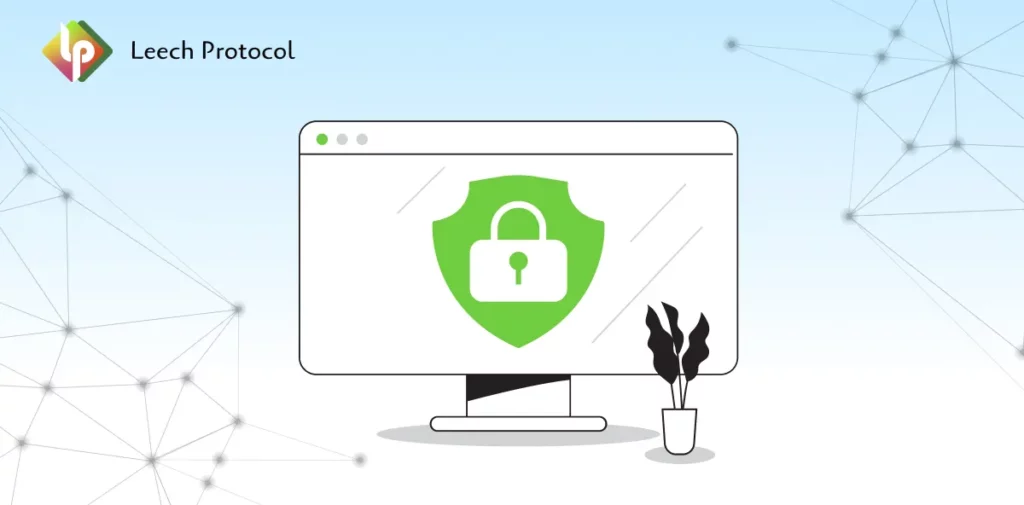Yield Farming Academy #2 Defi Ecosystems

This is the second lecture of a series on “Leech Protocol” from our Yield Farming Academy. In this tutorial, we will review the DeFi Ecosystems.
We will cover the following topics in this session:
- What is DeFI in general?
- What is a DeFI Ecosystem?
- The main components of every DeFi ecosystem
- The most critical products of the DeFi ecosystem
- Liquidity Circulation within DeFi Ecosystems
- Conclusions and home tasks?
So make yourself comfortable, grab your favorite beverage if you like, and let’s kick offour tech journey!
What is DeFi in general?
Decentralized finance, or DeFi, represents a new wave of innovation in the financial sector that initially began with the advent of the Ethereum blockchain and its smart contracts. So that we can understand Defi better, let’s begin by exploring its origins.

The traditional stock market, where you can buy and sell stocks, has an entire ecosystem of tools at its disposal in working with assets. This ecosystem includes exchanges for trading equities, lendings, futures and options markets, synthetic assets, derivatives, and much more.
This all began in the 17th century with the first stock exchange in Amsterdam and the first derivatives exchange in Japan. The modern stock market offers a variety of financial instruments that possess interconnectivity. For example, you can buy shares through an American broker, pledge them as collateral, take out a loan, and then invest the loan in an index fund. However, despite all of these possibilities, existing financial instruments have many limitations and problems that Web 3.0 technologies can solve. For instance, exchanges only operate at certain times, which creates inconvenience for trading on the other side of the world. Moreover, permission and queue waiting are required to obtain loans secured by various assets. The interfaces of these tools could be more appealing and convenient.
Web 3.0 technologies offer solutions to these problems. The Ethereum blockchain and its Solidity programming language allow the creation of a smart contract that can operate on a 24/7 basis worldwide. Interactions with smart contracts are accessible from anywhere and do not require a KYC for use. Applications built on smart contracts can perform the essential functions of stock market instruments. Thus, it is possible to improve the world of financial instruments by creating them on the blockchain.
In 2019, the first DeFi projects appeared on the Ethereum blockchain, such as Uniswap for asset exchange and MakerDAO for issuing stablecoins backed by Ethereum. These were the first steps in creating a new evolutionary financial world stage.
What is DeFI Ecosystem?
Decentralized Finance (DeFi) represents an ecosystem of financial instruments built on blockchain and web3 technologies.

In 2020, a period often referred to as the “DeFi Summer,” decentralized applications, or dApps, experienced explosive growth. Many new projects emerged to disrupt traditional finance during this time, and even separate blockchains were explicitly created for the new era of financial instruments. For instance, Binance Smart Chain was made as an alternative to Ethereum, as transaction fees on the Ethereum blockchain were very high. Subsequently, blockchains such as Polygon, Fantom, and others emerged as well.
New DeFi projects quickly appeared on these blockchains, forming a unique Financial ecosystem. Today, there are about 30 categories of decentralized financial instruments and approximately 2,500 working projects. Each of these projects perform specific functions that its developers embedded. Often, these functions were adapted from stock market instruments and improved by implementing Web3 technologies.
Developing its own DeFi ecosystem benefits each blockchain, as it creates utility for its main coin, ultimately increasing its market value. In addition to paying for gas transactions, the coin can be used, for example, as collateral in lending protocols. For example, you can get a USDT loan by pledging ETH.
Defi applications on each blockchain often interconnect, as they can be built on top of each other. For example, the LIDO protocol allows retail users to become validators and earn rewards by creating new Ethereum blocks. When you deposit ETH into LIDO, you receive a derivative that confirms your position in the LIDO protocol. This derivative is called stETH, and it trades freely on markets. There are also lending protocols that accept stETH as collateral for obtaining loans. You can exchange g stETH and get a USDT loan. The lending protocol is built on the assets from another protocol. This concept is called “DeFi Lego.” All these projects and their interconnections compose the DeFi ecosystem.
Components of every DeFi ecosystem
Each blockchain’s decentralized finance (DeFi) represents a complex ecosystem of various components and essential centers. DeFi represents these components through different projects that can be divided into categories. Projects in each category perform similar functions. For example, the “Lending” category includes various lending protocols. Here are some types of projects within the DeFi ecosystem and their functions:

Liquid Staking: These protocols enable you to become block validators without additional maintenance and earn rewards. Liquid Staking also provides a tradable and liquid token for your staked position.
Decentralized Exchanges (DEXs): These are protocols for asset exchanges. They use a peer-to-contract-to-peer model. Some users list assets in smart contracts, while others make asset exchanges.
Lending Platforms: These are platforms where users can lend and borrow cryptocurrencies. Interest rates are often determined by supply and demand dynamics within the platform.
Yield Farming: These products involve lending or staking cryptocurrencies in return for rewards, often in the form of additional cryptocurrency. Projects in this category can use simple and complex strategies to generate returns. Leech Protocol is a good example in Yield Farming niche.
Derivatives: These are blockchain-based contracts that derive value from an underlying asset. These assets can be cryptocurrencies or other real-world assets.
Asset Management Tools: These platforms help users manage their crypto investments across chains and products.
Liquidity Aggregators: These platforms pool liquidity from various sources to facilitate trading and improve liquidity.
Synthetics: These are blockchain-based financial instruments that mimic the value of real-world assets.
Options: These are financial derivatives that provide the buyer the right, but not the obligation, to buy or sell an asset at a specific price on or before a certain date.
NFT Marketplace: These platforms allow users to create, buy, and sell NFTs (Non-Fungible Tokens).
You can use dApps to customize solutions for your needs. Most users look for opportunities to earn some Yield using decentralized finance. But there are other examples of benefits for using DeFi projects. For instance, lending protocols can assist in everyday life. Imagine you have a cryptocurrency and need to make a large purchase. You have no funds available, and the only option is to sell cryptocurrency to make a purchase. If that’s the case, you can use a lending protocol and pledge your cryptocurrency as collateral, allowing you to take out a loan in stablecoins to make a purchase. You can gradually repay the loan and get back your collateral in the asset you pledged. Of course, this action creates an additional risk of liquidating your collateral if its value approaches the loan’s value – but that’s how lending works in traditional finance.
Critical products of the DeFi ecosystem
In decentralized finance (DeFi), each ecosystem is built on the foundation of critical projects that cater to users’ primary needs. Let’s look at these projects and their functions.

Liquid staking protocols allow users to earn staking rewards on their tokens while providing tradable and liquid derivatives for their deposited stake. These protocols enable ordinary users to participate in maintaining the blockchain and creating new blocks. It is possible by the Proof-of-Stake (PoS) consensus mechanism, where one of the conditions for becoming a validator is staking a certain amount of native tokens. Protocols collect the required deposit in parts, raise a validator, enable support, and distribute the received reward among the deposit owners according to the allocation. Liquid staking covers the basic needs of keeping the ecosystem and rewards for holding the primary token of the network. Also, liquid staking provides a tradable and liquid token for your staked position so you can use it in another DeFi protocol.
DEXs are exchange protocols. They are regular exchanges implemented exclusively on smart contracts and uploaded to the blockchain. DEXs also perform another vital function – the decentralized listing of new tokens. You can create your token and list it on the main DEX of any DeFi ecosystem, which immediately allows other users to buy and sell your new token.
Lending Protocols are needed to increase capital efficiency. They are essential for large players who can take a loan secured by tokens without selling them on the market and reducing the asset’s value. This way, they can leverage their capital on other projects.
Collateralized Debt Position (CDP) platforms create stablecoins backed by other assets like ETH or WBTC. Every DeFi ecosystem should have a stablecoin, as we are accustomed to valuing our holdings in dollars and still use state money in everyday life. Also, the hedging process or exit from these volatile assets often happens in dollars. For this reason, decentralized stablecoins are the most vital component of every ecosystem.
Cross-chain bridges allow for the decentralized transfer of liquidity between different blockchains and ecosystems. The volume of funds locked in each ecosystem depend on the convenience of transferring these funds into the DeFi ecosystem. The more opportunities to move liquidity, the more liquidity there will be.
These five types of projects exist in each DeFi ecosystem, among the top ten projects by the volume of locked funds. By carrying out the most primal functions, decentralized stablecoins form the foundation that enables the construction of higher financial instruments..
Liquidity Circulation within DeFi Ecosystems

Within each ecosystem, liquidity is not distributed randomly. The five primary protocols mentioned above comprise much of the total liquidity. Then, we have second-tier projects that improve capital efficiency or provide new functions based on the top products. There is also a third tier of projects, simply duplicates of the first and second-tier projects with additional minor tweaks. The inflow of liquidity will always occur through the largest first-tier protocols, then to the second, and so on. Major Investors want to avoid taking risks and will first go to protocols that have already proven themselves and have ample liquidity.
Conclusions
Now that you understand what DeFi ecosystems consist of, why they were constructed, and what properties these products in the ecosystem possess, We would like to thank you for participating in the Leech Farming Academy!
For additional examination and research topics, we recommend you read the book from Coingecko – “How to Defi” It provides a more detailed explanation of the properties of DeFi projects.
If you decide to build your portfolio and wager on the DeFi projects, we recommend that you follow the rules of diversification and choose several projects from different ecosystems in each category. This way, you can bet on the DeFi direction as a whole and not depend on the fate of one project by putting your eggs all in one basket.
Make sure to do your research before investing in any projects. We suggest not putting more than 30% of your money into cryptocurrencies. This area can be high-risk.
As a homework assignment, we recommend you test five projects from the first 7 DeFi ecosystems on DeFiLlama.
Tutorial on Using DeFiLlama
DeFiLlama is a DeFi data aggregator that provides stats around various DeFi protocols.
Here’s how to use it:
Go to the DeFiLlama website. On the main page, you will see a list of DeFi protocols sorted by TVL. You can click on each protocol to see more detailed information. Select “Chains” from the top menu to view DeFi protocols by blockchain. Select “Categories” from the top menu to view protocols by categories such as “DEXes”, “Lending”, “Derivatives”, etc. Use the search in the top right corner to find a specific protocol. Remember that DeFiLlama only provides information. Always conduct your research before investing in any DeFi project.



